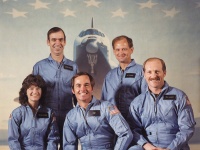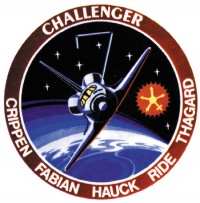STS-7
From The Space Library
 | |
| Organization | NASA-OfficeofSpaceScienceApplications(UnitedStates),NASA-Office of Space Flight (United States),BundesministeriumfuerForschungundTecnnologie(FederalRepublicofGermany) |
|---|---|
| Mission type | Human Crew,Microgravity |
| Launch date | June 18, 1983 |
| Launch vehicle | Space Shuttle |
| Launch site | Cape Canaveral, United States |
| COSPAR ID | 1983-059A |
| Inclination | 28.45 degrees |
| Experiments | Here |
| Alternate Names | OSTA 2/STS 7,14132 |
| Additional Information | Here |
| Data Collection | Here |
| Payload Mass Up | 16817 kg |
| Payload Mass Down | 10079.55 kg |
| Orbiter | Challenger |
| Lift Off Mass | 2,037,382.27 kg |
| Orbiter Weight at Liftoff | 113,262.73 kg |
| Orbiter Weight at Landing | 92,746.82 kg |
| Landed | Runway 15 dry lake bed at Edwards Air Force Base, Calif. |
| Orbits of Earth | 97 |
| Orbital Altitude | 160 nautical miles (184 statute miles) |
Contents |
[edit] Crew
- Commander: Robert L. Crippen
- Pilot: Frederick H. Hauck
- Mission Specialist 1: Sally K. Ride
- Mission Specialist 2: John M. Fabian
- Mission Specialist 3: Norman E. Thagard
[edit] Mission
On the seventh flight of the Space Shuttle (STS-7), Challenger carried a five-person crew on its second trip into space. The mission objectives for the STS-7 were (1) to carry and perform the experiments on the Office of the Space and Terrestrial Application (OSTA-2) payload, (2) to carry and operate the experiment packages monodisperse latex reactor (MLR) and continuous flow electrophoresis system (CFES), (3) to deploy the Canadian communication satellite Telesat-F, (4) to deploy the Indonesian communication satellite PALAPA-B1, (5) to complete attached and detached experiments with the Shuttle Pallet Satellite (SPAS-01, NSSDC ID 83-059F), and (6) to conduct experiments on seven Get-Away-Special (GAS) payloads. The OSTA-2 payload shared the cargo bay with Telesat-F, PALAPA-B1, SPAS-01, and seven GAS self-contained payload canisters. The SPAS-01 was deployed following attached operations and was retrieved for return to the orbiter after completing free-flying operations. The MLR and the CFES were mounted in the middeck area. The OSTA-2 payload was the first in a series of planned orbital investigations of materials processing in space. The OSTA-2 comprised the Materials Experiments Assembly (MEA), developed and managed by the Marshall Center, and the Materialwissenschaftliche Autonome Experiments unter Schwerelosigkeit (MAUS), developed by the German Ministry for Research and Technology (BMFT). The MEA was a desk-size package carrying two experiment furnaces and an acoustic levitator; each was contained inside individual experiment containers. The experiments were vapor growth of alloy-type semiconductor crystals, liquid phase miscibility gap materials, and containerless processing of glass-forming melts. The MAUS consisted of three instruments; each was contained in a get-away-special (GAS) canister. Each cylindrical canister carried an experiment furnace, which was thermally insulated, and had its own service module. The MAUS experiments were two metallic dispersions and a solidification front.
[edit] Payload
Office of Space and Terrestrial Applications (OSTA)-2 experiments; deployment of PALAPAB1 communications satellite for Indonesia with Payload Assist Module (PAM)-D and Telesat-F communications satellite for Canada with PAM-D; German Shuttle Pallet Satellite (SPAS)-01; seven getaway specials (GAS); Monodisperse Latex Reactor (MLR); Continuous Flow Electrophoresis System (CFES)
[edit] Books about the Space Shuttle Program
Buy This Book Click here |
Buy This Book here |
Buy This Book Click here |
Buy This Book Click here |





